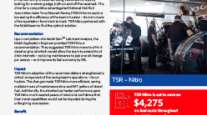Senior Reporter
Diesel Drops 4.6¢ a Gallon to $2.91

[Stay on top of transportation news: Get TTNews in your inbox.]
The price of diesel fuel declined 4.6 cents a gallon nationally Feb. 10, according to the U.S. Energy Information Administration, dipping to $2.91 a gallon from $2.956 the previous week.
Trucking’s primary fuel costs 5.6 cents a gallon less than it did a year ago. In the past two weeks, the price has fallen 10 cents a gallon.
The cost of diesel dropped in all nine EIA regions, from a range of 6.3 cents in the Midwest, where a gallon costs $2.776, to California, where the fuel dipped 2.8 cents to $3.784 a gallon. Diesel costs the most in California and the least in the Gulf Coast region, where it fell 3.5 cents to $2.675 a gallon.
U.S. average #diesel fuel price on 2/10/2020 was $2.910/gal, DOWN 4.6¢/gallon from 2/03/2020, DOWN 5.6¢/gallon from year ago https://t.co/8hHnVnPW5g #truckers #shippers #fuelprices pic.twitter.com/nPozh5uwZ6 — EIA (@EIAgov) February 11, 2020
The price of regular unleaded gasoline also declined nationwide, by 3.6 cents to $2.419 a gallon. Gas is down 8.7 cents in the past two weeks. As was the case with diesel, gasoline declined in all regions. However, even with the drop in prices, gas still costs 14.3 cents per gallon more than it did a year ago.
In the past two weeks, the price of West Texas Intermediate Crude, the industry benchmark, has dropped from more than $55 a barrel to $50.14 a barrel Feb.11.
Oil industry analyst Tom Kloza with the Oil Price Information Service told Transport Topics the drop in oil, causing a steep fall for refined products such as diesel and gasoline, can be traced to one item.

Kloza
“It’s all about the coronavirus,” he said, speaking about the deadly virus that has shut down substantial parts of China’s economy. “The last three weeks of it, I am going to say, it’s all about the coronavirus, and it’s all about the loss of Chinese demand and growth. Now we’re going to have Chinese economic destruction.”
In the past 20 years, China’s economy has grown from 4% of the world’s gross domestic product to approximately16%.
Because of the coronavirus, dozens of multinational corporations, including Apple, Toyota, Volkswagen, Panasonic and Foxconn, have suspended operations or reduced production at their Chinese facilities.
According to the General Administration of Customs, China is the world’s largest importer of crude oil at more than 11 million barrels per day. With millions of people not working because of shuttered factories, or staying home because of mandatory quarantines, Kloza says the spread of the virus means the country potentially could use millions of barrels a day less of oil. Kloza said that means there’s a glut of several million barrels of oil a day on the market, and that will drive prices lower for at least the first quarter of 2020.
“I think we’re going to see oil prices in the [forty-dollar range],” Kloza said. “We have about 11,000 locations across the country where gas prices are below $2. These are historically cheap prices in a generation.”
U.S. average price for regular-grade #gasoline on 2/10/2020 was $2.419/gal, DOWN 3.6¢/gallon from 2/03/2020, UP 14.3¢/gallon from year ago https://t.co/FL518ysZfJ #gasprices pic.twitter.com/6KEg8oJVO0 — EIA (@EIAgov) February 11, 2020
In Hudson, Ill., Nussbaum Transportation has been aggressively managing fuel consumption for its 450 trucks for several years. In 2017, the carrier participated in the North American Council for Freight Efficiency’s Run on Less program.
Chief Financial Officer Bill Wettstein told TT the lessons his company learned then are paying big dividends now, even as prices decline.
“The price that we’re paying now has fallen about 35 cents per gallon in the last three months,” he said.
Much of Nussbaum’s business is in the Midwest and East, but it operates trucks in the lower 48 states every week.

Wettstein
Nussbaum has instituted a fuel-efficiency program for its 420 drivers that rewards them with bonuses that can improve their base pay by as much as 15% depending on their driving habits.
“We focus on driver habits, fuel-efficient habits related to the speed they drive, the throttle they use and the braking, if they can coast versus brake,” Wettstein added.
The company also has a fuel-optimizer program that rewards drivers for buying fuel at specific preferred locations with the lowest prices.
“The drivers have incentives to fuel at the best, and second-best, fuel stops on their routes,” he said. “So, if they are compliant and they buy fuel where they should, where we want them to, they’ll get a bigger bonus, because the bigger truck stops are vying for our business.”
Nussbaum also has been aggressive with replacing older trucks, and Wettstein says the average age of the company’s fleet is less than 2½ years old.
Want more news? Listen to today's daily briefing:




